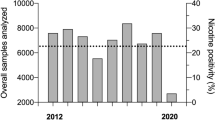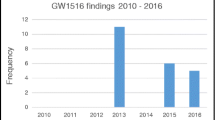Abstract
Although not yet fully recognised by international sporting committees, hair analysis in doping control may be a useful adjunct to drug testing of urine. It may permit access to retrospective information and the identification of banned substances, especially when exogenous abuse has to be distinguished from other forms of involuntary exposure to identical substances. Negative hair results coupled with positive urine samples may be used to draw conclusions of involuntary doping in sports whenever athletes claim not to have ingested any drug, identical substances are present in their environment or are normal constituents of food and beverages served to them immediately before the competition. Two cases are well described in the literature in which hair analyses were fundamental in documenting positive doping after urinalysis. In Brazil, 2 cases of athletes testing positive for banned substances caught our attention because of the possibility of involuntary doping; hair analysis, if performed, may have helped to clarify the results of the urinalysis.
Despite the fact that it cannot be used for routine control and overrule positive urinalysis, hair analysis can detect long term exposure as well as those substances which are not excreted in urine. In the current International Olympic Committee (IOC) code, hair analysis is not yet considered useful even in special cases of doping control.
Similar content being viewed by others
References
Wagner JC. Enhancement of athletic performance with drugs: an overview. Sports Med 1991; 12 (4): 250–65
Birkeland KAI, Hemmersbach P. The future of doping control in athletes: issues related to blood sampling. Sports Med 1999; 28: 25–33
International Olympic Committee (IOC). Olympic Movement Anti-Doping Code. Lausanne: IOC, 2000
Kintz P. Hair testing and doping control in sport. Toxicol Lett 1998; 102–3: 109–13
Sachs H, Kintz P. Consensus of the Society of Hair Testing on hair testing for doping agents. Forensic Sci Int 2000; 107 (1–3): 3
Rivier L. Is there a place for hair analysis in doping controls? Forensic Sci Int 2000; 107: 309–23
Kintz P, Cirimele V, Sachs H, et al. Testing for anabolic steroids in hair from two bodybuilders. Forensic Sci Int 1999; 101: 209–16
Fédération Internationale De Football Association (FIFA) — Comisión de Medicina Deportiva. Emmienda en los apéndices de los Reglamentos del Control de Dopaje de la FIFA. Circular. no. 630. Zurich: FIFA, 1997
Jenkins AJ, Llosa T, Montoya I, et al. Identification and quantitation of alkaloids in coca tea. Forensic Sci Int 1996; 77: 179–89
Meadway C, George S, Braithwaite R. Opiate concentrations following the ingestion of poppy seed products: evidence for ‘the poppy seed defence’. Forensic Sci Int 1998; 96: 29–38
Author information
Authors and Affiliations
Corresponding author
Rights and permissions
About this article
Cite this article
Midio, A.F., de Moraes Moreau, R.L. & Silva, O.A. The Possibilities of Hair Analysis in the Determination of Involuntary Doping in Sports. Sports Med 31, 321–324 (2001). https://doi.org/10.2165/00007256-200131050-00003
Published:
Issue Date:
DOI: https://doi.org/10.2165/00007256-200131050-00003




